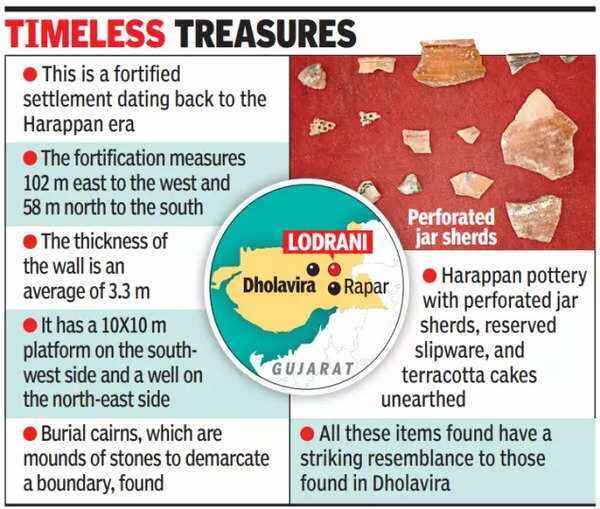
Morodharo

21.02.2024
Morodharo , Daily Current Affairs , RACE IAS : Best IAS Coaching in Lucknow
|
For Prelims:About Morodharo(Features),Key Facts about Harappan Civilization(The features of town planning) |
Why in the news?
Archaeologists recently discovered a Harappan-era fortified settlement named Morodharo.
About Morodharo:
- It is a fortified settlement dating back to the Harappan era.
- Location: Kutch District, Gujarat
Features:
- The settlement looks mature (2,600-1,900 BCE) to late (1,900-1,300 BCE) Harappan.
- The fortification measures 102 m east to the west and 58 m north to the south.
- The thickness of the wall is an average of 3.3 m.
- It has a 10x10 m platform on the south-west side and a well on the north-east.
- Burial cairns, which are mounds of stones to demarcate a boundary, are also found here.
- Harappan pottery with perforated jar sherds, reserved slipware, and terracotta cakes were unearthed. All these items have a striking resemblance to those found in Dholavira.
Key Facts about Harappan Civilization:
- It was the first urban civilisation in South Asia, coexisting with Mesopotamia and Egypt.
- This civilisation occupied the largest area (approximately 8,00,000 sq. km) among the three civilisations.
- Harappa (Punjab, Pakistan), Mohenjo-Daro (Sindh, Pakistan), Dholavira, Lothal, and Surkotada (Gujarat, India), Kalibangan in Rajasthan, and Banawali and Rakhigarhi (Haryana, India) are the major cities in the Harappan period.
The features of town planning of the Harappan civilisation included:
Rectangular grid pattern: The Harappan cities were designed on a grid pattern, with streets running in a north-south and east-west direction, forming well-organized Streets and lanes cutting across one another almost at right angles, thus dividing the city into several rectangular blocks.
Planned streets and alleyways: The streets and alleyways of Harappan cities were planned and constructed with precision. They were wide enough to allow the movement of carts and pedestrians, and some streets had covered drains running alongside them.
Fortification: The cities were surrounded by fortified walls made of mud bricks, providing protection against robbers, cattle raiders, and floods.
Material used: They used burnt bricks on a large scale in almost all kinds of constructions, and there was the absence of stone buildings during Harappan culture.
Source:The Times of india